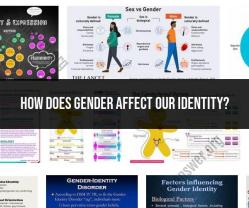How does gender affect our identity?
Gender can significantly impact an individual's identity in several ways:
Self-Perception: An individual's gender identity, whether it aligns with their assigned sex at birth or not, plays a fundamental role in how they perceive themselves. Gender identity can strongly influence self-esteem, self-confidence, and self-acceptance.
Social Roles and Expectations: Society often assigns specific roles, behaviors, and expectations to individuals based on their gender. These social constructs can shape a person's identity by influencing how they interact with others, what they perceive as their responsibilities, and the opportunities available to them.
Cultural Norms: Different cultures have varying norms and beliefs about gender roles and identities. Cultural factors can significantly impact how individuals view and express their gender, leading to diverse identities and experiences.
Interactions and Relationships: Gender can affect how individuals interact with others and form relationships. People may have different expectations and assumptions about individuals based on their perceived gender, which can impact how they are treated and how they view themselves in relation to others.
Identity Development: Gender identity is a crucial component of overall identity development. For many individuals, understanding and accepting their gender identity is a central part of their journey to self-discovery and self-acceptance.
Mental Health and Well-Being: The intersection of gender and identity can have a significant impact on mental health and well-being. Individuals who face discrimination, prejudice, or rejection based on their gender identity may experience increased stress, anxiety, or depression, which can, in turn, affect their overall identity and self-perception.
Advocacy and Activism: Some individuals may incorporate their gender identity into their broader identity as advocates or activists. They may work to raise awareness, challenge stereotypes, and promote equality and acceptance for people of all gender identities.
It's important to note that the relationship between gender and identity is complex and deeply personal. Each person's experience is unique, and individuals may express their gender identity in various ways. Respect for diversity in gender identities and a commitment to inclusivity are essential for creating a more equitable and understanding society.




